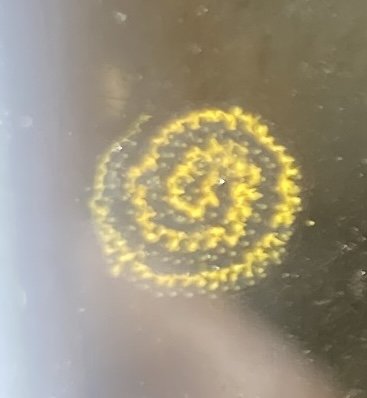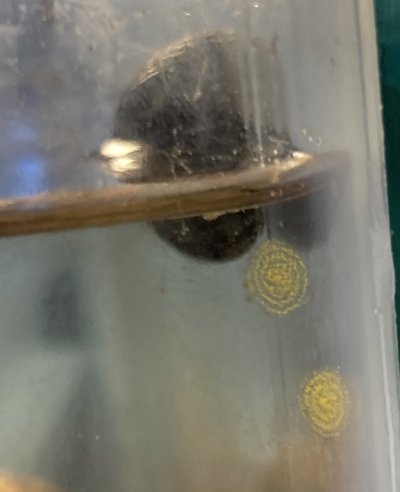Navigation
Install the app
How to install the app on iOS
Follow along with the video below to see how to install our site as a web app on your home screen.

Note: This feature currently requires accessing the site using the built-in Safari browser.
More options
You are using an out of date browser. It may not display this or other websites correctly.
You should upgrade or use an alternative browser.
You should upgrade or use an alternative browser.
spiral plaque of eggs?
- Thread starter Greengirl
- Start date
redfishbluefish
Stay Positive, Stay Productive
- Review score
- +0 /0 /-0
Staff member
Super Moderator
Reef Squad
Partner Member 2023
R2R Supporter
R2R Excellence Award
Article Contributor
NJRC Member
Hospitality Award
Build Thread Contributor
- Joined
- Mar 22, 2012
- Messages
- 11,529
- Reaction score
- 25,036
- Review score
- +0 /0 /-0
- Location
- Sayreville, NJ
What snails do you have? I know Cerith snails make spiral egg masses.
EeyoreIsMySpiritAnimal
Just another girl who likes fish
- Review score
- +0 /0 /-0
Partner Member 2023
Build Thread Contributor
- Joined
- May 14, 2019
- Messages
- 7,940
- Reaction score
- 11,218
- Review score
- +0 /0 /-0
- Location
- Spring, Texas
EeyoreIsMySpiritAnimal
Just another girl who likes fish
- Review score
- +0 /0 /-0
Partner Member 2023
Build Thread Contributor
- Joined
- May 14, 2019
- Messages
- 7,940
- Reaction score
- 11,218
- Review score
- +0 /0 /-0
- Location
- Spring, Texas
Never seen anything like that. Hopefully others with more knowledge can help ID.What is this? Found a couple of these 3-5 mm diameter plaques on the glass walls near the air surface. No fish in this aquarium, but lots of pods, tube worms, snails, anemone, and a pair of Elysia tucca sea slugs. I was hoping the slugs would breed but this doesn't look like their kind of egg mass.
View attachment 2981611 View attachment 2981612
Right...googling along suggestion of cerith snails and that looks right. Maybe my dwarfs or my Florida ceriths, but not anything new to the tank : ). Thanks Paul!
ISpeakForTheSeas
2500 Club Member
- Review score
- +0 /0 /-0
R2R Supporter
R2R Excellence Award
- Joined
- Nov 22, 2021
- Messages
- 3,058
- Reaction score
- 3,640
- Review score
- +0 /0 /-0
- Location
- United States
I'm actually thinking this is the Elysia eggs - for example of Elysia sp. eggs see image G below (there are other species with similar egg spirals too):What is this? Found a couple of these 3-5 mm diameter plaques on the glass walls near the air surface. No fish in this aquarium, but lots of pods, tube worms, snails, anemone, and a pair of Elysia tucca sea slugs. I was hoping the slugs would breed but this doesn't look like their kind of egg mass.
View attachment 2981611 View attachment 2981612
Source: https://www.researchgate.net/figure...ss-A-B-Live-specimens-resting_fig58_306006471
OMG!!! That would make me soooooo happy. Hope you are right! And in fact the pic looks a lot more like these than the snail eggs. I just hope the copepods or whatever don't eat the eggs before they can hatch. Also weird to me that the slugs prefer to lay the eggs up high on clear glass than down in the plants, but who am I to judge. I did notice one slug up in that vacinity recently so could be that's why. How long before they hatch?
ISpeakForTheSeas
2500 Club Member
- Review score
- +0 /0 /-0
R2R Supporter
R2R Excellence Award
- Joined
- Nov 22, 2021
- Messages
- 3,058
- Reaction score
- 3,640
- Review score
- +0 /0 /-0
- Location
- United States
For most species, it seems they tend to prefer to lay on algae, but sometimes they'll lay on the glass anyway. I'm not exactly sure how long before the eggs hatch for your species, but given that Elysia timida takes up to 3 weeks, E. clarki ~16-18 days, and E. cornigera ~15-19 days, I'd guess your eggs would be in that same range. So, probably 2 to 3 weeks.OMG!!! That would make me soooooo happy. Hope you are right! And in fact the pic looks a lot more like these than the snail eggs. I just hope the copepods or whatever don't eat the eggs before they can hatch. Also weird to me that the slugs prefer to lay the eggs up high on clear glass than down in the plants, but who am I to judge. I did notice one slug up in that vacinity recently so could be that's why. How long before they hatch?
Sometimes with E. timida and E. cornigera (and likely with some other species too), the eggs will hatch into fully formed, crawling juveniles, but most of the time they hatch into free-swimming veliger larvae (the veligers don't typically survive in our tanks, but the crawling juveniles likely would).
I just found this reference that specifically documented E. tuca and I'm hopeful with some fresh H. incrassata the hatchlings will morph and survive. Fingers crossed.For most species, it seems they tend to prefer to lay on algae, but sometimes they'll lay on the glass anyway. I'm not exactly sure how long before the eggs hatch for your species, but given that Elysia timida takes up to 3 weeks, E. clarki ~16-18 days, and E. cornigera ~15-19 days, I'd guess your eggs would be in that same range. So, probably 2 to 3 weeks.
Sometimes with E. timida and E. cornigera (and likely with some other species too), the eggs will hatch into fully formed, crawling juveniles, but most of the time they hatch into free-swimming veliger larvae (the veligers don't typically survive in our tanks, but the crawling juveniles likely would).
Attachments
ISpeakForTheSeas
2500 Club Member
- Review score
- +0 /0 /-0
R2R Supporter
R2R Excellence Award
- Joined
- Nov 22, 2021
- Messages
- 3,058
- Reaction score
- 3,640
- Review score
- +0 /0 /-0
- Location
- United States
Great find with that document - good luck!I just found this reference that specifically documented E. tuca and I'm hopeful with some fresh H. incrassata the hatchlings will morph and survive. Fingers crossed.
Similar threads
- Replies
- 11
- Views
- 180
- Replies
- 36
- Views
- 974
- Replies
- 5
- Views
- 909
- Replies
- 12
- Views
- 471
- Replies
- 155
- Views
- 4,114















